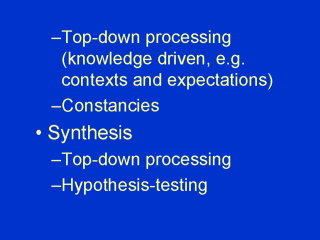| front |1 |2 |3 |4 |5 |6 |7 |8 |9 |10 |11 |12 |13 |14 |15 |16 |review |
 |
Top-down processing is driven by
knowledge-based processes, such as expectations and context which provide collateral
information about the likely nature of the input. Constancies are rule-driven processes that characterize perception. Constancies have been identified for colour, shape, size, brightness and location. They are most apparent in the visual system but may also be present in other perceptual modalities. For example, size constancy refer to the feature that an object seems to retain a relatively constant size relative to other objects, while shape constancy refers to the experience that, despite the angular distortion in the retinal image that occurs when, for example a cube is viewed from different perspectives, it is still recognized as a cube - the “cubism” of the object remains a constant feature despite quite extreme deviations in the geometric characteristics of the retinal image. A second element of constancy is that sensory features of objects are consistently seen as object characteristics, and not simply as sensory features. This “objectification” of what are essentially sensory characteristics illustrates the most powerful feature of perception; its ability to construct a virtual reality. We become so used to this that we forget it is only a construction, and not really “real”. |